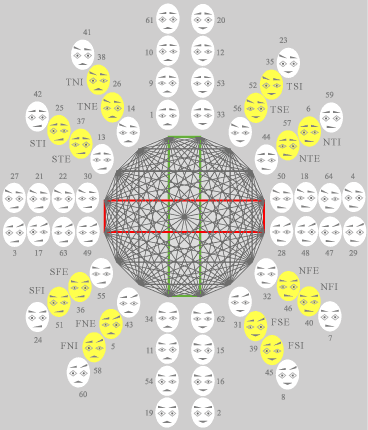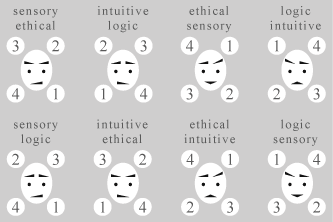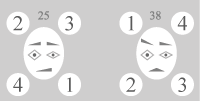-
In C. G. Yung's analytical psychology it has not been told about
interrelations of psychological types and transactions of mental functions, but
in socionics there is the information about intertype attitudes
of 16 psycho-types, about which look the detailed information on pages of other website
www.numeralgame.64g.ru where intertype
attitudes are shown in a context of
analytical numerology.
Ratio of psycho-types in socionics can be considered according to kinds or
variants of ratio of 64 psychological types in analytical physiognomy, as 64
types are the developed chart, and 16 types of socionics or otherwise to tell
base types of Myers-Briggs Type Indicator are shown if features of a human face
correspond to physiognomic symbols which are noted on the chart by yellow color.
 |
Physiognomic symbols of psychological types in
analytical physiognomy correspond to displays of base psycho-types of
Myers-Briggs Type Indicator and to pseudonyms which correspond with
names of gods of the Greek Mythology. 25th - STI sensory-logic introvert Poseidon. 37th - STE sensory-logic extravert Hera. 38th - TNI logic-intuitive introvert Hermes Trismegistus. 26th - TNE logic-intuitive extravert Prometheus. 52nd - TSI logic-sensory introvert Hermes Propillar. 56th - TSE logic-sensory extravert Hephaestus. 6th - NTI intuitive-logic introvert Hecate. 57th - NTE intuitive-logic extravert Apollo. 40th - NFI intuitive-ethical introvert Dionysus. 46th - NFE intuitive-ethical extravert Artemis. 45th - FSI ethical-sensory introvert Eris. 39th - FSE ethical-sensory extravert Aphrodite Dione. 58th - FNI ethical-intuitive introvert Aphrodite Urania. 5th - FNE ethical-intuitive extravert Ares. 51st - SFI sensory-ethical introvert Leto. 36th - SFE sensory-ethical extravert Zeus. |
If features of a human face correspond to the listed types of analytical
physiognomy and psycho-types of Myers-Briggs Type Indicator then mutual
relations of people can be considered from the view point of intertype attitudes
which are known in socionics. But if features of a human face correspond to
other types of analytical physiognomy in the shown ring chart then it is
necessary to consider relations of people in view of the counterbalanced or
unbalanced interrelations of mental functions, about what it is told on the
previous page. For example, if faces of people correspond to physiognomic
symbols of 25th and 46th psychological types of analytical physiognomy then
mutual relations are dual in a context of socionics, but if faces of people
correspond to 25th and 48th types then mutual relations are caused by
interrelations of mental functions of explicit 25th type and contrast 48th type,
and consequently relations are others rather than intertype attitudes in socionics.
For the detailed analysis of interrelations of mental functions and for the
description of intertype attitudes in a context of analytical physiognomy within
the shown ring chart it is necessary to consider leading and minor mental
functions, that is shown on the following chart.
 |
Numbers on the chart specify leading and minor mental
functions according to parities with features of a human face. Number 1 specifies leading (conducting) function which is strong, namely a person is competent according to this function. Number 2 specifies actual function according to which a person carries out actions and realizes competencies of the first leading function. Number 3 specifies weak function according to which a person perceives own incompetence. Number 4 specifies non-actual function according to which a person supposes participation of people in realization of actions. More detailed information on leading and minor functions of a human personality look on pages of website www.numeralgame.64g.ru. |
-
For example, in sensory-ethical types:
- first strong function corresponds with active sensorics that corresponds to
the left corner of a mouth;
- second actual function corresponds with obvious ethics that corresponds to the
left eyebrow;
- third weak function corresponds with unobvious logics that corresponds to the
right eyebrow;
- fourth non-actual function corresponds with passive intuition that corresponds
to the right corner of a mouth.
The listed parities of mental functions with features of a face are
symbolical, and in essence terminology is conditional, namely if one function is
active then opposite function is passive, and if one function is obvious then
opposite function is unobvious. And similarly features of a face are active and
passive or obvious and unobvious, that symbolically corresponds with facial
physiognomy.
According to properties of leading and minor mental functions it is possible to
analyze intertype attitudes of explicit and contrast and harmonious
psychological types in a context of analytical physiognomy.
For example, interrelations of mental functions of explicit 25th type and
explicit 38th type.
 |
25th psychological type of analytical physiognomy is
shown as sensory-logic. 38th psychological type of analytical physiognomy is shown as logic-intuitive. |
The first strong function of 25th type coincides with the third weak
function of 38th type that causes contradictions in mutual relations, namely
38th type perceives own incompetence in comparison with 25th type.
The first strong function of 38th type coincides with the second actual
function of 25th type that does not cause contradictions as 38th type realizes
own competence of that area where 25th type carries out competent actions.
The third weak function of 25th type coincides with the fourth non-actual
function of 38th type that does not cause contradictions as 38th type does not
notice area in which 25th type feels incompetence.
The second actual function of 38th type coincides with the fourth
non-actual function of 25th type that can cause contradictions as 25th type does
not give value to life spheres in which 38th type carries out competent actions.
It is necessary to consider that obvious mental functions counterbalance
displays of active functions in view of analytical physiognomy. In particular in
the resulted example, obvious intuition of 38th type counterbalance active
sensorics of 25th type that smoothes contradictions, and in essence 25th type
perceives incompetence of own sensorics in comparison with strong sensorics of
25th type not painfully owing to obvious intuition which is in harmonious ratio
with unobvious sensorics, namely owing to harmonious ratio of irrational mental
functions.
Namely in view of analytical physiognomy it is necessary to consider obvious
functions, and also possible ambiguous displays of contrast and harmonious
psychological types, and including ambiguous displays connected with mobile
features of a human face. For example, mutual relations of people whose faces
correspond to physiognomic symbols of 25th and 58th psychological types are
disputed, but if corners of a mouth in features of a human face are mobile, and
in essence if corners of a mouth can be identical or if a person can smile both
corners of a mouth, then 25th type can change in 12th type, namely a person can
be shown as 12th type in mutual relations with 58th type and as a result in
mutual relations there will be no conflict. As obvious sensory function of 12th
type will not be painful for weak sensory function of 58th type. Or a person can
smile other corner of a mouth and as a result 25th type will change in 6th type,
that also will change interrelations of mental functions.
The following page results some other examples which explain principles of analytical physiognomy and interrelations of mental functions which can be seen in features of a human face.
-